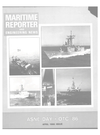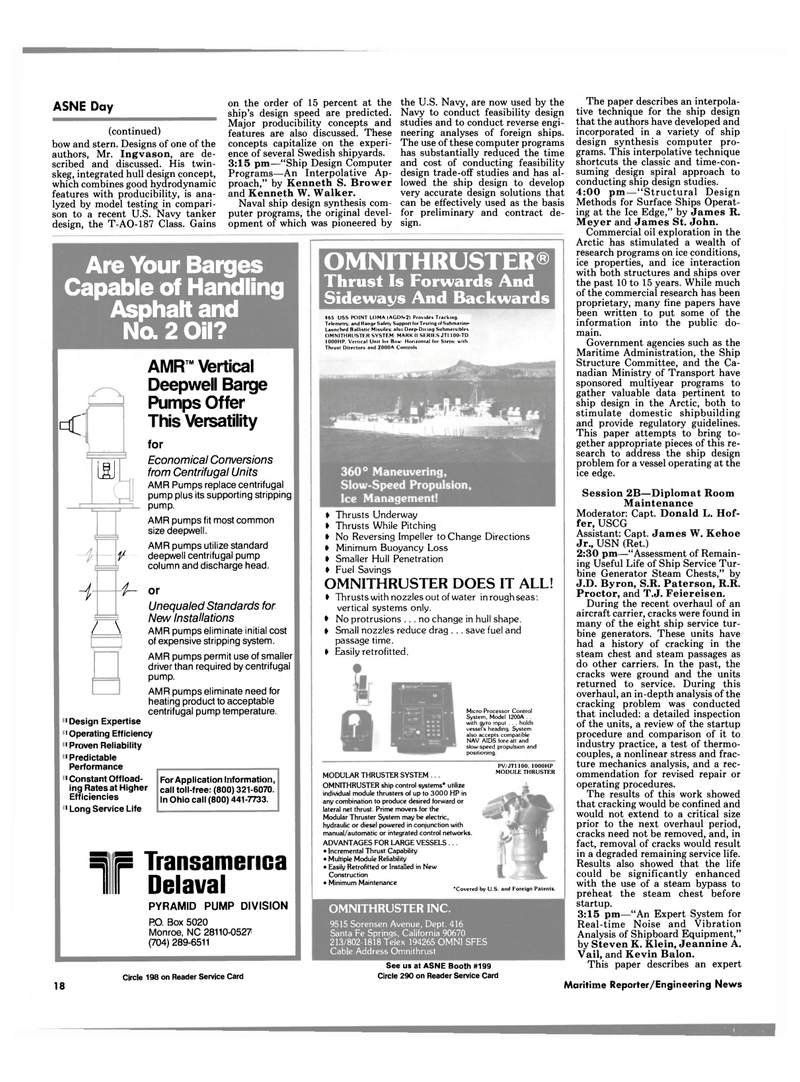
Page 14: of Maritime Reporter Magazine (April 1986)
Read this page in Pdf, Flash or Html5 edition of April 1986 Maritime Reporter Magazine
ASNE Day (continued) bow and stern. Designs of one of the authors, Mr. Ingvason, are de- scribed and discussed. His twin- skeg, integrated hull design concept, which combines good hydrodynamic features with producibility, is ana- lyzed by model testing in compari- son to a recent U.S. Navy tanker design, the T-AO-187 Class. Gains on the order of 15 percent at the ship's design speed are predicted.
Major producibility concepts and features are also discussed. These concepts capitalize on the experi- ence of several Swedish shipyards. 3:15 pm—"Ship Design Computer
Programs—An Interpolative Ap- proach," by Kenneth S. Brower and Kenneth W. Walker.
Naval ship design synthesis com- puter programs, the original devel- opment of which was pioneered by the U.S. Navy, are now used by the
Navy to conduct feasibility design studies and to conduct reverse engi- neering analyses of foreign ships.
The use of these computer programs has substantially reduced the time and cost of conducting feasibility design trade-off studies and has al- lowed the ship design to develop very accurate design solutions that can be effectively used as the basis for preliminary and contract de- sign.
Are Your Barges
Capable of Handling
Asphalt and
Na 2 Oil?
V -i 4-
L\ •Design Expertise 1 Operating Efficiency •Proven Reliability 1 Predictable
Performance 1 Constant Offload- ing Rates at Higher
Efficiencies 1 Long Service Life
AMR™ Vertical
Deepwell Barge
Pumps Offer ~
This Versatility for
Economical Conversions from Centrifugal Units
AMR Pumps replace centrifugal pump plus its supporting stripping pump.
AMR pumps fit most common size deepwell.
AMR pumps utilize standard deepwell centrifugal pump column and discharge head. or
Unequaled Standards for
New Installations
AMR pumps eliminate initial cost of expensive stripping system.
AMR pumps permit use of smaller driver than required by centrifugal pump.
AMR pumps eliminate need for heating product to acceptable centrifugal pump temperature.
For Application Information, call toll-free: (800) 321-6070.
In Ohio call (800) 441-7733.
T Transamenca Delaval
PYRAMID PUMP DIVISION
RO. Box 5020
Monroe, NC 28110-0527 (704) 289-6511
OMNITHRUSTER®
Thrust Is Forwards And
Sideways And Backwards 465 USS POINT LOMA (AGDS-2I Provides Tracking.
Telemetry. and Range Safety Support lor Testing ol Submarine-
Launched Ballistic Missiles: also Deep-Diving Submersibles.
OMNITHRUSTER SYSTEM: MARK II SERIES JTI100-TD
I000HP. Vertical Unit lor Bou- Horizontal lor Stern: with
Thrust Directors and 2000A Controls » Thrusts Underway » Thrusts While Pitching • No Reversing Impeller to Change Directions • Minimum Buoyancy Loss • Smaller Hull Penetration • Fuel Savings
OMNITHRUSTER DOES IT ALL! » Thrusts with nozzles out of water in rough seas: vertical systems only. • No protrusions ... no change in hull shape. » Small nozzles reduce drag ... save fuel and passage time. » Easily retrofitted.
Micro Processor Control
System. Model 1200A . . with gyro inpul . . . holds vessel's heading. System also accepts compatible
NAV AIDS (ore alt and slow-speed propulsion and positioning.
PV/JTI 100. 1000HP
MODULAR THRUSTER SYSTEM .. . MODULE THRUSTER
OMNITHRUSTER ship control systems* utilize individual module thrusters of up to 3000 HP in any combination to produce desired forward or lateral net thrust. Prime movers for the
Modular Thruster System may be electric, hydraulic or diesel powered in conjunction with manual/automatic or integrated control networks.
ADVANTAGES FOR LARGE VESSELS . . . • Incremental Thrust Capability • Multiple Module Reliability • Easily Retrofitted or Installed in New
Construction • Minimum Maintenance 'Covered by U.S. and Foreign Patents. 18
Circle 198 on Reader Service Card
OMNITHRUSTER INC. 9515 Sorensen Avenue, Dept. 416
Santa Fe Springs, California 90670 213/802-1818 Telex 194265 OMNI SFES
Cable Address Omnithrust
See us at ASNE Booth #199
Circle 290 on Reader Service Card
The paper describes an interpola- tive technique for the ship design that the authors have developed and incorporated in a variety of ship design synthesis computer pro- grams. This interpolative technique shortcuts the classic and time-con- suming design spiral approach to conducting ship design studies. 4:00 pm—"Structural Design
Methods for Surface Ships Operat- ing at the Ice Edge," by James R.
Meyer and James St. John.
Commercial oil exploration in the
Arctic has stimulated a wealth of research programs on ice conditions, ice properties, and ice interaction with both structures and ships over the past 10 to 15 years. While much of the commercial research has been proprietary, many fine papers have been written to put some of the information into the public do- main.
Government agencies such as the
Maritime Administration, the Ship
Structure Committee, and the Ca- nadian Ministry of Transport have sponsored multiyear programs to gather valuable data pertinent to ship design in the Arctic, both to stimulate domestic shipbuilding and provide regulatory guidelines.
This paper attempts to bring to- gether appropriate pieces of this re- search to address the ship design problem for a vessel operating at the ice edge.
Session 2B—Diplomat Room
Maintenance
Moderator: Capt. Donald L. Hof- fer, USCG
Assistant: Capt. James W. Kehoe
Jr., USN (Ret.) 2:30 pm—"Assessment of Remain- ing Useful Life of Ship Service Tur- bine Generator Steam Chests," by
J.D. Byron, S.R. Paterson, R.R.
Proctor, and T.J. Feiereisen.
During the recent overhaul of an aircraft carrier, cracks were found in many of the eight ship service tur- bine generators. These units have had a history of cracking in the steam chest and steam passages as do other carriers. In the past, the cracks were ground and the units returned to service. During this overhaul, an in-depth analysis of the cracking problem was conducted that included: a detailed inspection of the units, a review of the startup procedure and comparison of it to industry practice, a test of thermo- couples, a nonlinear stress and frac- ture mechanics analysis, and a rec- ommendation for revised repair or operating procedures.
The results of this work showed that cracking would be confined and would not extend to a critical size prior to the next overhaul period, cracks need not be removed, and, in fact, removal of cracks would result in a degraded remaining service life.
Results also showed that the life could be significantly enhanced with the use of a steam bypass to preheat the steam chest before startup. 3:15 pm—"An Expert System for
Real-time Noise and Vibration
Analysis of Shipboard Equipment," by Steven K. Klein, Jeannine A.
Vail, and Kevin Balon.
This paper describes an expert
Maritime Reporter/Engineering News

 13
13

 15
15
